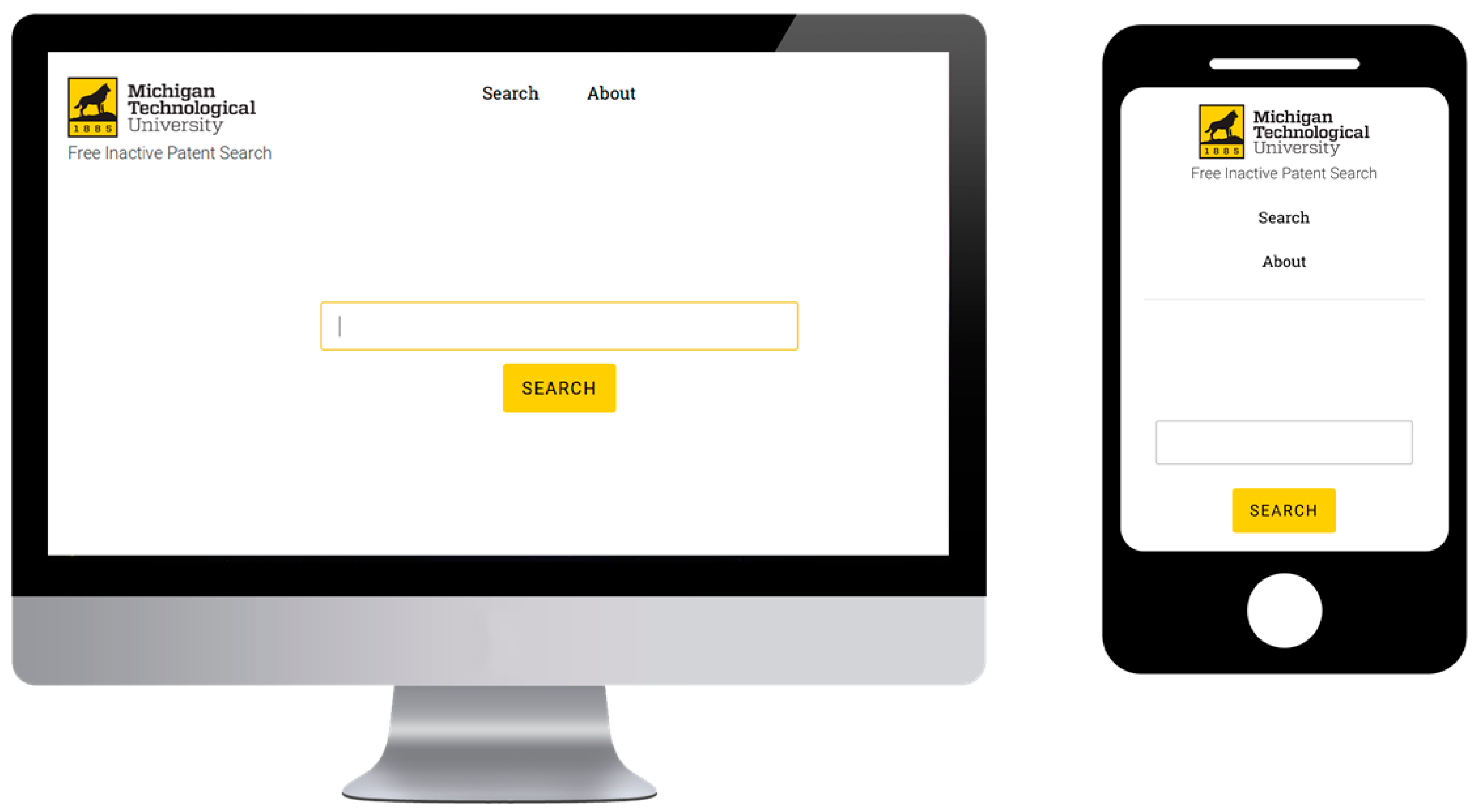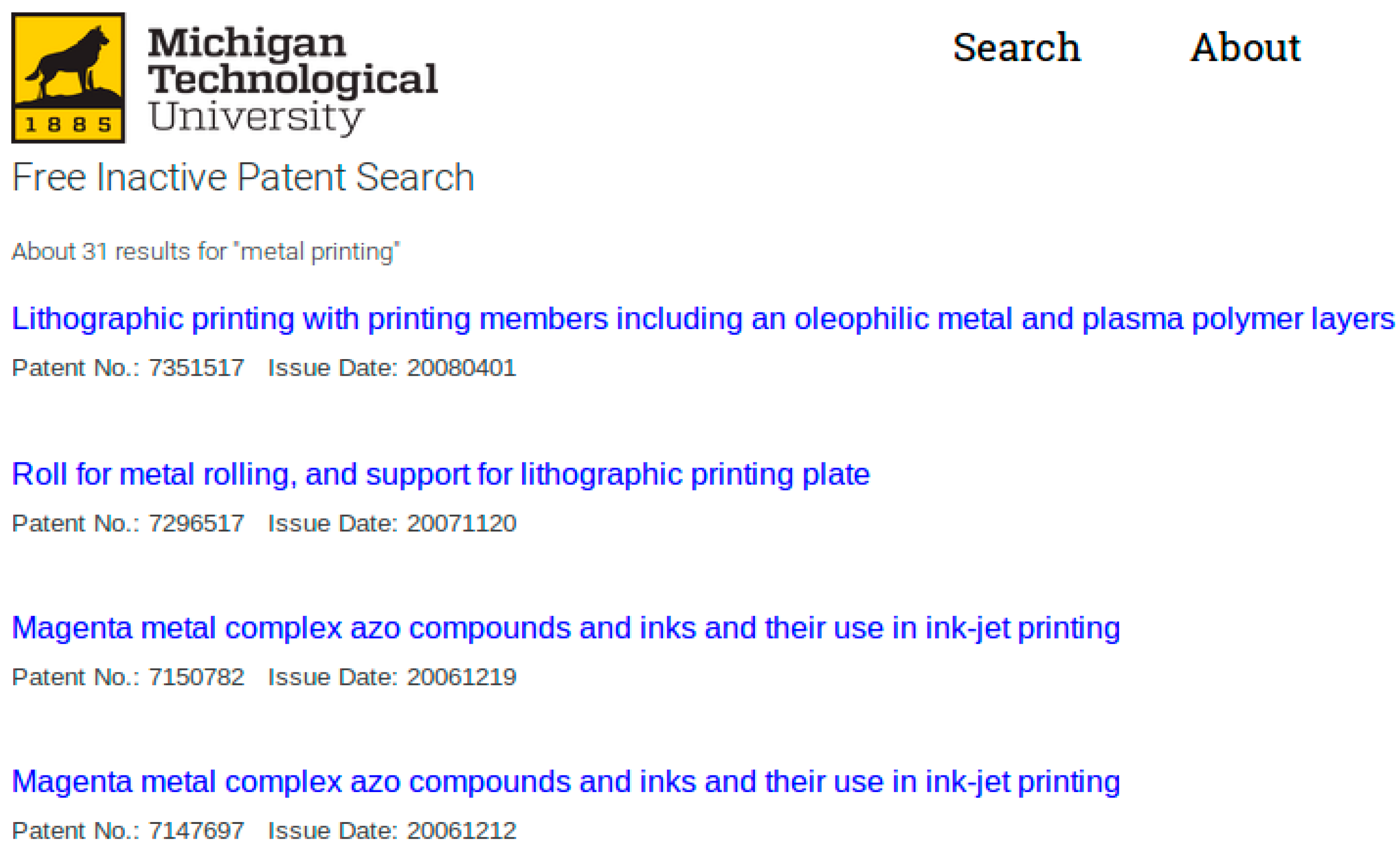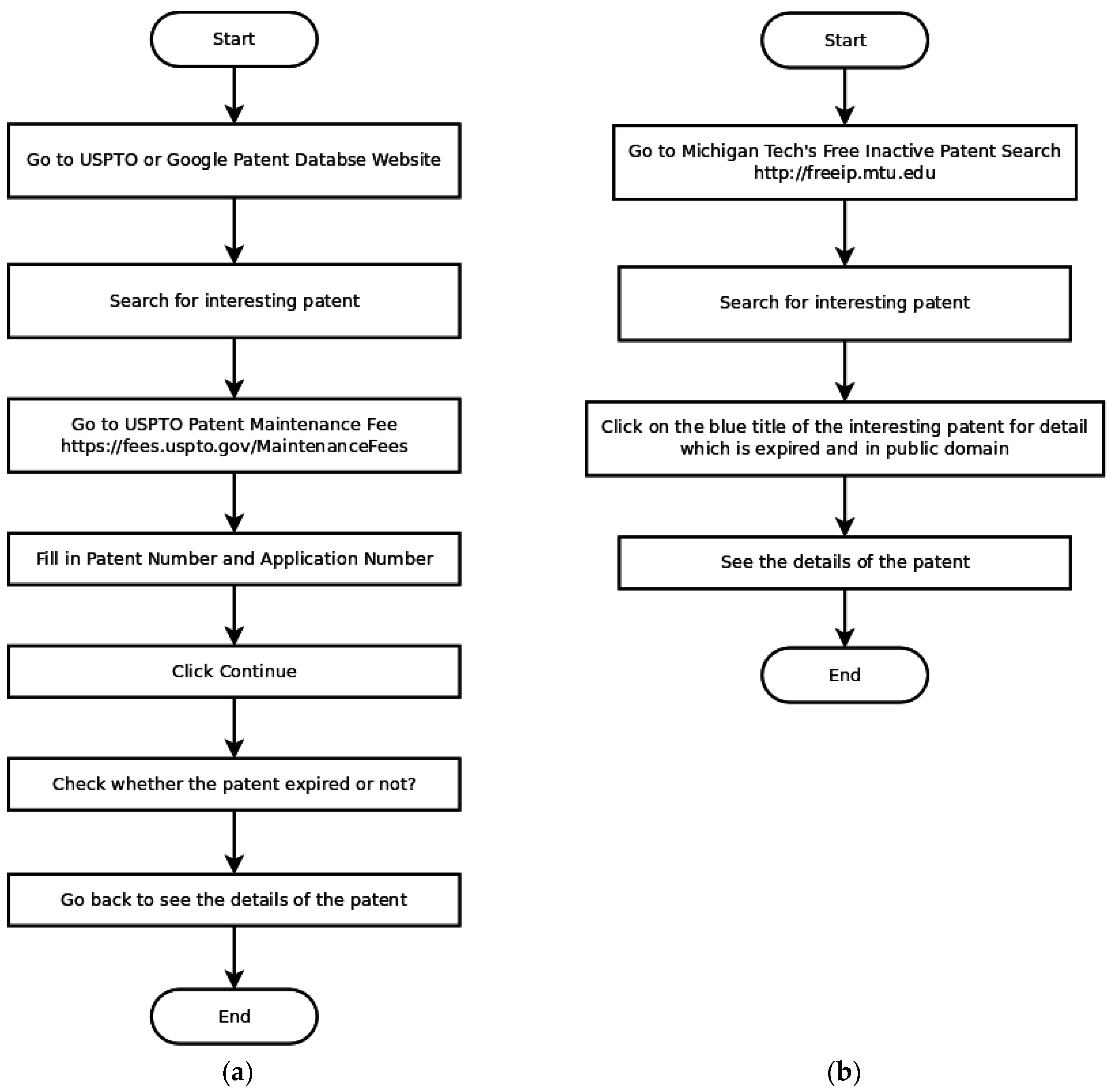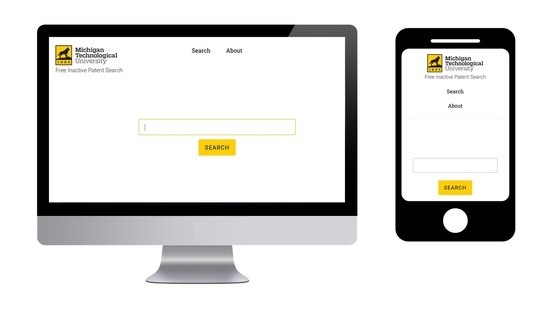Open Source Database and Website to Provide Free and Open Access to Inactive U.S. Patents in the Public Domain
Abstract
:1. Introduction
2. Materials and Methods
2.1. Database
2.2. The Full Text Patent File Format
2.3. TXT File Processing
2.4. SGML File Processing
2.5. XML File Processing
2.6. Patent Maintenance Fee Events Data Processing
2.7. Automatically Update Weekly
2.8. Website Implementation
2.9. The Current Approach
2.10. An Alternative Option
3. Results
4. Discussion
5. Conclusions
Acknowledgments
Author Contributions
Conflicts of Interest
Appendix A
MySQL Database Script
| Field Name | Data Type | Primary Key | Index |
|---|---|---|---|
| us_patent_number | varchar (8) | Yes | |
| us_patent_title | varchar (500) | Yes | |
| us_patent_issue_date | int (11) | ||
| us_term_of_grant | int (11) |
| Field Name | Data Type | Primary Key | Index |
|---|---|---|---|
| us_patent_number | varchar (7) | Yes | |
| us_patent_title | varchar (500) | Yes | |
| us_patent_issue_date | int (11) | ||
| us_term_of_grant | int (11) |
| Field Name | Data Type | Primary Key | Index |
|---|---|---|---|
| us_patent_number | varchar (7) | ||
| us_application_number | varchar (8) | ||
| Small_entity | varchar (1) | ||
| us_application_filing_date | int (11) | ||
| us_grant_issue_date | int (11) | ||
| maintenance_fee_event_entry_date | int (11) | ||
| maintenance_fee_event_code | varchar (5) |
| Field Name | Data Type | Primary Key | Index |
|---|---|---|---|
| us_patent_number | varchar (7) | Yes |
References
- Patent Term. Available online: http://www.uspto.gov/web/offices/pac/mpep/s2701.html (accessed on 11 June 2016).
- McGrath, R. The pace of technology adoption is speeding up. In The End of Competitive Advantage; Harvard Business Review Press: Watertown, MA, USA, 25 November 2013. [Google Scholar]
- Heller, M.A.; Eisenberg, R.S. Can patents deter innovation? The anticommons in biomedical research. Science 1998, 280, 698–701. [Google Scholar] [CrossRef] [PubMed]
- Joel, D. Pools, thickets and open source nanotechnology. Eur. Intell. Prop. Rev. 2009, 31, 300–306. [Google Scholar]
- McKendrick, J. Time to eliminate patents altogether? Fed paper urges more open innovation. ZDNet. 29 September 2012. Available online: http://www.zdnet.com/article/time-to-eliminate-patents-altogether-fed-paper-urges-more-open-innovation/ (accessed on 11 June 2016).
- Ridley, M. A welcome turn away from patents. Wall Street J. Available online: http://www.wsj.com/articles/SB10001424127887324520904578553700647653828 (accessed on 11 June 2016).
- Murphy, E. Patent activity at a high but decline in scientific research could show innovation slowing. Intellectual Property Watch. 6 April 2015. Available online: http://www.ip-watch.org/2015/06/04/report-patent-activity-at-a-high-but-decline-in-scientific-research/ (accessed on 11 June 2016).
- Wadhwa, V. Here’s why patents are innovation’s worst enemy. The Washington Post. 11 March 2015. Available online: https://www.washingtonpost.com/news/innovations/wp/2015/03/11/heres-why-patents-are-innovations-worst-enemy/ (accessed on 11 June 2016).
- Kinsella, S. The Case against Intellectual Property. In Handbook of the Philosophical Foundations of Business Ethics; Springer: Dordrecht, The Netherlands, 2013; pp. 1325–1357. [Google Scholar]
- Kinsella, N.S. Against intellectual property. J. Libert. Stud. 2001, 15, 1–53. [Google Scholar]
- Boldrin, M.; Levine, D.K. The case against intellectual property. Am. Econ. Rev. 2002, 92, 209–212. [Google Scholar] [CrossRef]
- Boldrin, M.; Levine, D.K. Against Intellectual Monopoly; Cambridge University Press: Cambridge, UK, 2008. [Google Scholar]
- Takalo, T.; Kanniainen, V. Do patents slow down technological progress? Real options in research, patenting, and market introduction. Int. J. Ind. Organ. 2000, 18, 1105–1127. [Google Scholar] [CrossRef]
- Bessen, J.; Meurer, M.J. Patent Failure: How Judges, Bureaucrats, and Lawyers Put Innovators at Risk; Princeton University Press: Princeton, NJ, USA, 2008. [Google Scholar]
- Feldman, R.; Lemley, M.A. Do patent licensing demands mean innovation? Iowa Law Rev. 2015, 101, 137–189. [Google Scholar]
- Pearce, J.M. Open-source nanotechnology: Solutions to a modern intellectual property tragedy. Nano Today 2013, 8, 339–341. [Google Scholar] [CrossRef]
- Mushtaq, U.; Pearce, J.M. Open source appropriate nanotechnology. In Nanotechnology and Global Sustainability; CRC Press: Boca Raton, FL, USA, 2012; pp. 191–213. [Google Scholar]
- Osborn, L.S.; Pearce, J.; Haselhuhn, A. The case for weaker patents. St. John’s Law Rev. 2016, 89, 1185–1253. [Google Scholar] [CrossRef]
- Raymond, E. The cathedral and the bazaar. Knowl. Technol. Policy 1999, 12, 23–49. [Google Scholar] [CrossRef]
- DiBona, C.; Ockman, S.; Stone, M. Open Sources: Voices from the Open Source Revolution, 1st ed.; O’Reilly: Sebastopol, CA, USA, 1999. [Google Scholar]
- Lakhani, K.; Hippel, E.V. How Open Source software works: “Free” user-to-user assistance. Res. Policy 2003, 32, 923–943. [Google Scholar] [CrossRef]
- Deek, F.P.; McHugh, J.A.M. Open Source: Technology and Policy; Cambridge University Press: New York, NY, USA, 2008. [Google Scholar]
- Soderberg, J. Hacking Capitalism: The Free and Open Source Software Movement; Routledge: Abingdon-on-Thames, UK, 2008. [Google Scholar]
- Rolandsson, B.; Bergquist, M.; Ljungberg, J. Open source in the firm: Opening up professional practices of software development. Res. Policy 2011, 40, 576–587. [Google Scholar] [CrossRef]
- Colombo, M.G.; Piva, E.; Rossi-Lamastra, C. Open innovation and within-industry diversification in small and medium enterprises: The case of open source software firms. Res. Policy 2014, 43, 891–902. [Google Scholar] [CrossRef]
- Henkel, J.; Schöberl, S.; Alexy, O. The emergence of openness: How and why firms adopt selective revealing in open innovation. Res. Policy 2014, 43, 879–890. [Google Scholar] [CrossRef]
- Dodourova, M.; Bevis, K. Networking innovation in the European car industry: Does the Open Innovation model fit? Transp. Res. A Policy Pract. 2014, 69, 252–271. [Google Scholar] [CrossRef]
- Boudreau, K.J.; Lakhani, K. Innovation experiments: Researching Technical advance, knowledge production and the design of supporting institutions. In Innovation Policy and the Economy; University of Chicago Press: Chicago, IL, USA, 2015. [Google Scholar]
- Alexy, O.; Henkel, J.; Wallin, M.W. From closed to open: Job role changes, individual predispositions, and the adoption of commercial open source software development. Res. Policy 2013, 42, 1325–1340. [Google Scholar] [CrossRef]
- Hienerth, C.; von Hippel, E.; Berg Jensen, M. User community vs. producer innovation development efficiency: A first empirical study. Res. Policy 2014, 43, 190–201. [Google Scholar] [CrossRef]
- Årdal, C.; Røttingen, J.-A. Financing and collaboration on research and development for nodding syndrome. Health Res. Policy Syst. 2016, 14, 19. [Google Scholar] [CrossRef] [PubMed] [Green Version]
- Petch, A.; Lightowler, C.; Pattoni, L.; Watson, I. Embedding research into practice through innovation and creativity: A case study from social services. Evid. Policy 2014, 10, 555–564. [Google Scholar] [CrossRef]
- Garcia Martinez, M. Solver engagement in knowledge sharing in crowdsourcing communities: Exploring the link to creativity. Res. Policy 2015, 44, 1419–1430. [Google Scholar] [CrossRef]
- Fisher, D.; Gould, P. Open-source hardware is a low-cost alternative for scientific instrumentation and research. Mod. Instrum. 2012, 1, 8–20. [Google Scholar] [CrossRef]
- Pearce, J.M. Open-Source Lab: How to Build Your Own Hardware and Reduce Research Costs; Elsevier: Amsterdam, The Netherlands, 2014. [Google Scholar]
- USPTO Patent Full-Text Image Database. Available online: http://patft.uspto.gov/netahtml/PTO/search-adv.htm (accessed on 16 July 2016).
- Google Patents. Available online: https://patents.google.com/ (accessed on 27 July 2016).
- Maintain Your Patent. Available online: http://www.uspto.gov/patents-maintaining-patent/maintain-your-patent (accessed on 16 July 2016).
- Patent Maintenance Fees. Available online: http://patentlyo.com/patent/2012/09/patent-maintenance-fees.html (accessed on 16 July 2016).
- Application Information Retrieval. Available online: http://portal.uspto.gov/pair/PublicPair (accessed on 16 July 2016).
- MySQL. Available online: http://www.mysql.com/ (accessed on 16 July 2016).
- About WordPress. Available online: https://wordpress.com/about/ (accessed on 16 July 2016).
- System Requirements. Available online: https://www.drupal.org/requirements (accessed on 16 July 2016).
- Installing Joomla. Available online: https://docs.joomla.org/J3.x:Installing_Joomla (accessed on 16 July 2016).
- Why MySQL? Available online: http://www.mysql.com/why-mysql/ (accessed on 16 July 2016).
- United States Patent and Trademark Office Bulk Data Downloads. Available online: http://patents.reedtech.com/ (accessed on 27 July 2016).
- Patent Grant Red Book (Full Text). Available online: http://patents.reedtech.com/pgrbft.php (accessed on 27 July 2016).
- Patent Maintenance Fee Events (1 September 1981–Present). Available online: http://patents.reedtech.com/maintfee.php (accessed on 27 July 2016).
- USPTO—Patent Maintenance Fees. Available online: https://fees.uspto.gov/MaintenanceFees (accessed on 27 July 2016).
- Patent Maintenance Fee Events 1981 to Present. Available online: http://patents.reedtech.com/downloads/PatentMaintFeeEvents/1981-present/MaintFeeEvents.zip (accessed on 29 July 2016).
- Wohlers, T. Wohlers Report 2016; Wohlers Associates, Inc.: Fort Collins, CO, USA, 2016. [Google Scholar]
- Rundle, G. A Revolution in the Making; Simon and Schuster: New York, NY, USA, 2014. [Google Scholar]
- Jones, R.; Haufe, P.; Sells, E.; Iravani, P.; Olliver, V.; Palmer, C.; Bowyer, A. RepRap—The replicating rapid prototyper. Robotica 2011, 29, 177–191. [Google Scholar] [CrossRef]
- Bowyer, A. 3D printing and humanity’s first imperfect replicator. 3D Print. Addit. Manuf. 2014, 1, 4–5. [Google Scholar] [CrossRef]
- Osborn, L.S.; Pearce, J.M.; Haselhuhn, A. A case for weakening patent rights. St. John’s Law Rev. 2015, 89, 1185–1253. [Google Scholar]
- Kruth, J.P.; Leu, M.C.; Nakagawa, T. Progress in additive manufacturing and rapid prototyping. CIRP Ann. Manuf. Technol. 1998, 47, 525–540. [Google Scholar] [CrossRef]
- Bak, D. Rapid prototyping or rapid production? 3D printing processes move industry towards the latter. Assem. Autom. 2003, 23, 340–345. [Google Scholar] [CrossRef]
- Lipson, H.; Kurman, M. Fabricated: The New World of 3D Printing; John Wiley & Sons: Hoboken, NJ, USA, 2013. [Google Scholar]
- Gwamuri, J.; Wittbrodt, B.T.; Anzalone, N.C.; Pearce, J.M. reversing the trend of large scale and centralization in manufacturing: The case of distributed manufacturing of customizable 3-D-printable self-adjustable glasses. Chall. Sustain. 2014, 2, 30–40. [Google Scholar] [CrossRef]
- Statistics on Consumer Mobile Usage and Adoption to Inform Your Mobile Marketing Strategy Mobile Site Design and App Development. Available online: http://www.smartinsights.com/mobile-marketing/mobile-marketing-analytics/mobile-marketing-statistics/ (accessed on 27 July 2016).
- Pearce, J.M. Quantifying the value of open source hardware development. Mod. Econ. 2015, 6, 1–11. [Google Scholar] [CrossRef]
- Pearce, J.M. Return on investment for open source scientific hardware development. Sci. Public Policy 2016, 43, 192–195. [Google Scholar] [CrossRef]
- Wittbrodt, B.T.; Glover, A.G.; Laureto, J.; Anzalone, G.C.; Oppliger, D.; Irwin, J.L.; Pearce, J.M. Life-cycle economic analysis of distributed manufacturing with open-source 3-D printers. Mechatronics 2013, 23, 713–726. [Google Scholar] [CrossRef]
- Laplume, A.; Anzalone, G.C.; Pearce, J.M. Open-source, self-replicating 3-D printer factory for small-business manufacturing. Int. J. Adv. Manuf. Technol. 2016, 85, 633–642. [Google Scholar] [CrossRef]
- Petrick, I.J.; Simpson, T.W. 3D printing disrupts manufacturing: How economies of one create new rules of competition. Res.-Technol. Manag. 2013, 56, 12–16. [Google Scholar] [CrossRef]
- Laplume, A.O.; Petersen, B.; Pearce, J.M. Global value chains from a 3D printing perspective. J. Int. Bus. Stud. 2016, 47, 595–609. [Google Scholar] [CrossRef]
- Patent Grant Single Page Images—Yellow Book. Available online: http://patents.reedtech.com/pgyb.php (accessed on 27 July 2016).




| Year | File Format | Bash Script | Input |
|---|---|---|---|
| 1976–2000 | TXT | Import-full-text-patent-txt.sh | URL |
| 2001–2004 | SGML (2001) and XML (2002–2004) | Import-full-text-patent-sgml.sh | URL |
| 2005–Present | XML | Import-full-text-patent-xml.sh | URL |
© 2016 by the authors; licensee MDPI, Basel, Switzerland. This article is an open access article distributed under the terms and conditions of the Creative Commons Attribution (CC-BY) license (http://creativecommons.org/licenses/by/4.0/).
Share and Cite
Nilsiam, Y.; Pearce, J.M. Open Source Database and Website to Provide Free and Open Access to Inactive U.S. Patents in the Public Domain. Inventions 2016, 1, 24. https://doi.org/10.3390/inventions1040024
Nilsiam Y, Pearce JM. Open Source Database and Website to Provide Free and Open Access to Inactive U.S. Patents in the Public Domain. Inventions. 2016; 1(4):24. https://doi.org/10.3390/inventions1040024
Chicago/Turabian StyleNilsiam, Yuenyong, and Joshua M. Pearce. 2016. "Open Source Database and Website to Provide Free and Open Access to Inactive U.S. Patents in the Public Domain" Inventions 1, no. 4: 24. https://doi.org/10.3390/inventions1040024








